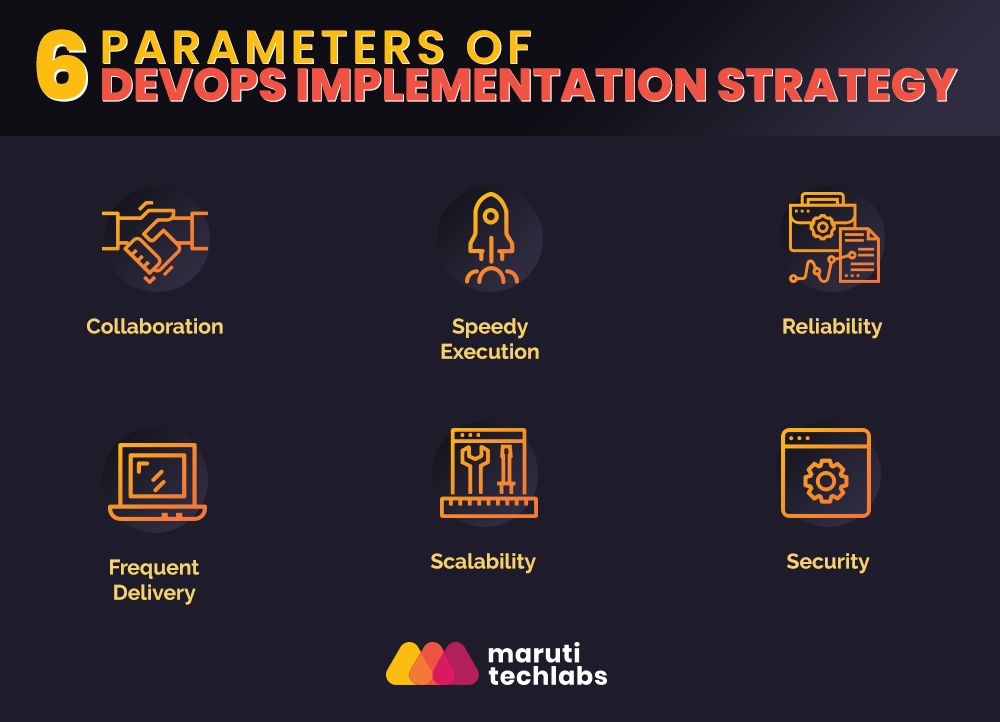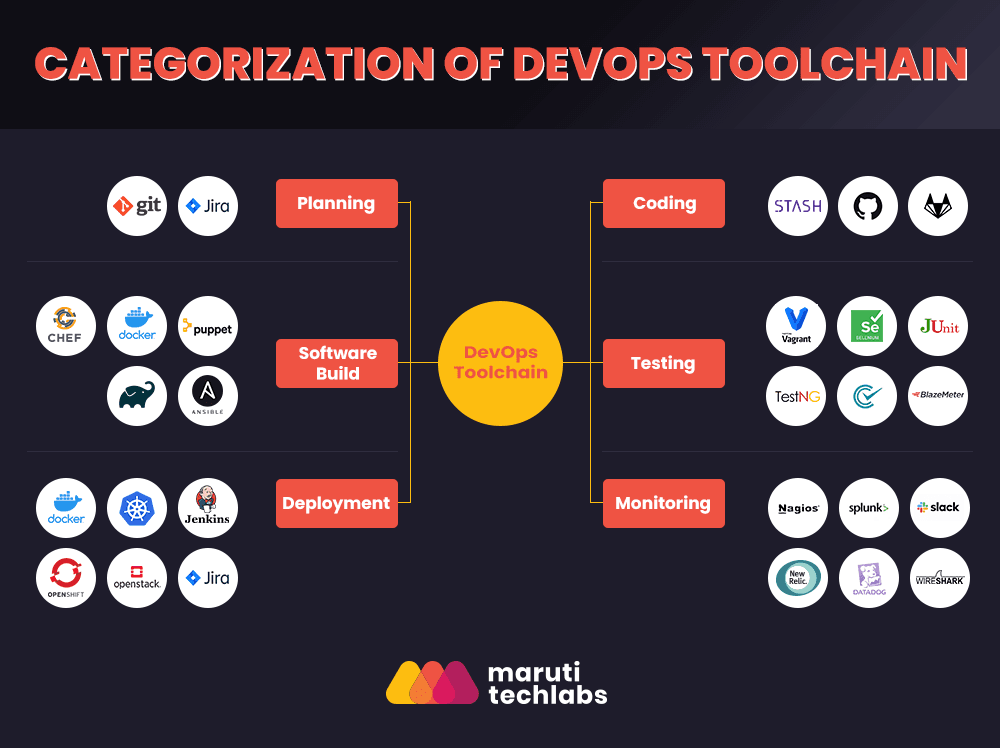

Boosting Your DevOps Game: 12 Must-Have DevOps Tools You Need






The popularity of DevOps, in recent years, as a robust software development and delivery process has been unprecedented. As we talked about in our previous piece of the same series, DevOps is essentially the integration of two of the most important verticals in IT – development and operations – that brings a whole new perspective to the execution of software development. DevOps implementation is largely about bringing a cultural transformation where both development and operations teams collaborate and work seamlessly. Let us learn about DevOps implementation strategy and the top DevOps tools available in the market today.
The primary goal of DevOps is to improve collaboration between various stakeholders right from planning to deployment to maintenance of the IT project to be able to –
The DevOps implementation approach is categorized into 3 main stages of the software development life cycle:
The concept of DevOps implementation integrates development, operations and testing departments together into collaborative cross-functional teams with the aim of improving the agility of overall IT service delivery.
The focus of DevOps is largely on easing delivery processes and standardizing development environments with the aim of improving efficiency, security and delivery predictability. DevOps empowers teams and gives them the autonomy to build, deliver, validate, and support their own software applications. It provides developers with a better understanding of the production infrastructure and more control of the overall production environment.

As an organization, your DevOps journey begins by defining the existing business procedures, IT infrastructure, and delivery pipelines, followed by crafting clear objectives that the DevOps implementation strategy is expected to achieve for your organization.
Although DevOps is implemented with different variations in different organizations, the common phases of DevOps process consist the 6C’s as discussed below-
Some of the key benefits of DevOps implementation include:
Does that mean there are no hurdles to DevOps adoption?
Not necessarily! Similar to any other approach, DevOps adoption also comes with certain hiccups. Although the concept of DevOps is a decade old now, there are certain aspects that need to be taken care of so that they don’t become hurdles in embracing the collaborative IT practice. Let us have a look at some of the key points-
DevOps implementation reduces number of project failures and rollbacks, and as a result, reduces the overall IT cost in the long run. However, if not planned properly, the cost of shifting to DevOps practice can burn a hole in your pocket. Planning the budget is a crucial step before DevOps implementation.
Hiring competent DevOps professionals is a necessity when it comes to successful DevOps adoption in any organization. To achieve this, it is imperative to hire skillful DevOps consultants capable of managing the teams and building a collaborative culture.
Infrastructure complexity is yet another challenge in successful DevOps implementation as organizations find it difficult to create a common infrastructure out of different services and apps deployed in isolated environments. Educating teams on why the organization has decided to make the shift to DevOps, planning the DevOps implementation roadmap, and hiring competent DevOps consultant go a long way in managing the complex infrastructural changes.
The first step before you move to any new technology is the proper identification of resources and building a team competent enough to take on the challenges that come with the execution of an IT project. Some of the qualities to look for while identifying members of the DevOps team include critical thinking to find the root cause of the issue, proficiency in the latest DevOps tools & zeal to learn new ones, and an ability to troubleshoot and debug efficiently to solve the problems. Securing a DevOps team equipped with the mentioned capabilities can be challenging. Suppose your endeavors to attain these skills prove to be unproductive. In that case, engaging with a consultancy specializing in DevOps advisory services is recommended. A competent team can execute flawless delivery of software, starting from collating requirements, planning the implementation path, and finally deploying the software.
The DevOps implementation strategy is essentially built on six parameters-

It is wise to start with small initiatives before making an organizational shift to DevOps. Small-scale changes provide the benefit of manageable testing and deployment. Next steps of DevOps implementation at the organizational level should be decided based on the outcome.
Considering the fact that faster & speedy execution lies in the backbone of DevOps, automation becomes crucial to your implementation strategy. With carefully chosen automation tools, manual hand-offs are eliminated and processes are carried out at a faster speed saving time, effort and a total budget of the organization.
For successful DevOps implementation, it is crucial to prepare the right environment of continuous testing & continuous delivery. Even a small change in the application should be tested at different phases of the delivery process. Similarly, preparing a continuous delivery environment ensures that any kind of change or addition of code is quickly deployed to production depending on the success or failure of the automated testing.
This is one of the most important steps of DevOps implementation process. The selection of tools should be based on their compatibility with your unique IT environment for smooth integration. The right toolset allows you to build a robust infrastructure with customized workflows and access controls which provides enhanced usage and smooth functionality.
There are a number of DevOps tools that help in ensuring effective implementation; however, finding the best ones requires continuous testing and experimentation. The primary objective of these tools is to streamline and automate the different stages of software delivery pipeline/workflow.
The DevOps toolchain can be broken down into various lifecycle stages (mentioned below) with dedicated tools for each.
This is the most important phase that helps in defining business value and requirements.
Examples of tools- Git, Jira
It involves the detailed process of software design and the creation of software code.
Examples of tools- Stash, GitHub, GitLab
During this phase, you essentially manage various software builds and versions with the help of automated tools that assist in compiling and packaging code for future release to production.
Examples of tools- Docker, Puppet, Chef, Ansible, Gradle.
It is the phase of continuous testing that ensures optimal code quality.
Example of tools- Vagrant, Selenium, JUnit, Codeception, BlazeMeter, TestNG
This is the phase of managing, scheduling, coordinating, and automating various product releases into production.
Examples of tools – Jenkins, Kubernetes, Docker, OpenShift, OpenStack, Jira.
Monitoring is the phase of identifying and collecting information about different issues after software release in production.
Examples of tools- Nagios, Splunk, Slack, New Relic, Datadog, Wireshark.

Since no single tool works across all areas of development and delivery. The need is to first understand your processes and accordingly map the tool to be successfully establish DevOps culture in the organization:
Elucidated below are the top 12 DevOps tools which can be used in different phases of the software development cycle:
An excellent DevOps automation tool being adopted by an increasing number of software development teams, Jenkins is essentially an open-source CI/CD server that helps in automating the different stages of the delivery pipeline. The huge popularity of Jenkins is attributed to its massive plugin ecosystem (more than 1000) allowing it to be integrated with a large number of other DevOps tools including Puppet, Docker, and Chef.
Features of Jenkins
Widely used across software industries, Git is a distributed SCM (source code management) DevOps tool. It allows you to easily track the progress of your development work where you can also save different versions of source code and return to a previous one as and when required.
Features of Git
One of the most popular free and open-source DevOps monitoring tools, Nagios allows you to monitor your infrastructure real-time so that identifying security threats, detection of outages, and errors becomes easier. Nagios feeds out reports and graphs, allowing for real-time infrastructure monitoring.
Features of Nagios
Splunk is designed to make machine data usable as well as accessible to everyone by delivering operational intelligence to DevOps teams. It is an excellent choice of tool that makes companies more secure, productive and competitive.
A forerunner in containerization, Docker is one of the widely used development tools of DevOps and is known to provide platform-independent integrated container security and agile operations for cloud-native and legacy applications.
Features of Docker
Ideal for large teams, this DevOps tool is built on what Docker started in the field of containerization. It is a powerful tool that can group containers by logical categorization.
Features of Kubernetes
Ansible is primarily an agentless design management and organization DevOps tool. It is written in simple programming language YAML. It makes it easier for DevOps teams to scale the process of automation and speed up productivity.
Features of Ansible
Vagrant is a popular DevOps tool that can be used in conjunction with various other management tools to let developers create virtual machine environments in the same workflow. In fact, an increasing number of organizations have started using Vagrant to help transition into the DevOps culture.
Features of Vagrant
An extremely versatile DevOps tool, Gradle allows you to write your code in various languages, including C++, Java, and Python, among others. It is supported by popular IDEs including Netbeans, Eclipse, and IntelliJ IDEA.
Features of Gradle
Chef is a popular Ruby-based arrangement management tool which allows DevOps engineers to consider configuration management as a competitive advantage instead of a probable hurdle. The tool is mainly used for checking the configurations, and it also helps in automating the infrastructure.
Features of Chef
Worksoft is another popular DevOps tool that offers incredible support for both web and cloud applications. It has a robust ecosystem of solutions for various enterprise applications spanning across the entire pipeline of continuous delivery.
Features of Worksoft
Puppet is an open-source configuration management tool that is used for deploying, configuring and managing servers.
Features of Puppet
DevOps approach is here to stay, and it will continue to be implemented by enterprises increasingly in the future. In fact, a recent research conducted by Technavio estimated a whopping 19% CAGR (Compound Annual Growth Rate) in the global DevOps market (from 2016–2020) highlighting the goldmine of benefits implementing DevOps holds.
To ensure successful implementation of DevOps process, it is essential to plan out a solid DevOps strategy and select DevOps tools that fit in well with other tools and the development environment. We, at Maruti Techlabs, have successfully enabled DevOps transformation for various enterprises and companies. Our DevOps experts help you through each step of the transformative journey to ensure your business scales new heights in the long run. Simply drop us a note here for your end-to-end DevOps needs.


